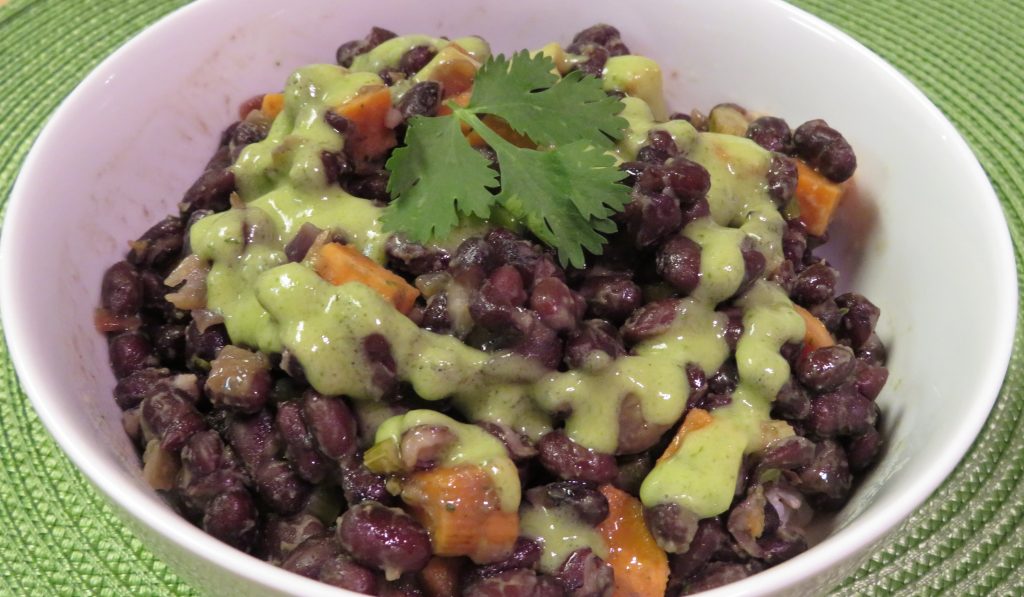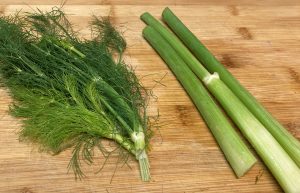Potluck Picnics (and Some Good News about Lectins)

Earlier this week I began talking about summer salads, and today I offer you this Black Bean Salad with Avocado Dressing for your July 4th celebration and for ongoing summer picnics and potluck events.
In the past my go-to veggies to accompany most any black bean dish would have been red bell peppers and tomatoes, but now I find myself looking for something different.
Some Facts about Nightshades
Since last summer’s wrist fracture that left an inflammatory condition in both my hands, I have carefully restricted myself to an anti-inflammatory diet. For this reason, I’ve denied myself the pleasures of peppers and tomatoes, which are both in the nightshade family.
Besides peppers and tomatoes, other members of the nightshade family include eggplants, white potatoes, and chilies, including both cayenne and paprika. These nightshades all contain a chemical known as alpha-solanine, which triggers inflammation and joint pain in many people. Sadly, if you suffer from chronic pain, particularly arthritis, even if you are (as I am!) a lover of tomatoes or any of the vegetables named here, you may want to consider eliminating these nightshades for a month or two to see if your pain level decreases. It has certainly helped me!
Please, do not let this suggestion spoil your day. I have learned to be ever-more creative with the foods that support my healing process, and I invite you to do the same. Just because I’ve given up nightshades doesn’t mean I’ve sacrificed all things delicious, as today’s recipe will testify.
The Hype about Lectins
Since we are talking about an anti-inflammatory diet, I’d also like to address a claim that has circulated widely on the internet over the past several years regarding legumes and lectins. Lectins are a type of protein that binds to carbohydrates and is found throughout the natural world of plants, animals, and microorganisms. Today, many health practitioners and KETO diet facilitators, in particular, are scaring thousands of people away from eating legumes because they contain carbohydrates and lectins.
Of course, vegans and vegetarians rely on legumes for a protein-rich diet—so this advice might be disturbing if it weren’t so misleading. The legume family includes all beans, lentils, grams (dals), and peanuts. Once legumes have been soaked and cooked, most of the lectins are inactivated. I have this information from many reliable sources, two of which I will cite here: the The Harvard School of Public Health and Ocean Robbins, founder of the Food Revolution Network.
Legumes have been a primary protein in Asian and Mediterranean cultures for millennia, and they are known to support robust health. Legumes are an excellent source of protein, necessary carbohydrates, and antioxidants—all nutrients that are required for optimal health and energy. (Carbs also get a bad rap, but they are as essential to good health as protein!) People who have participated in our 21-Day Delicious Detox Challenge will tell you that it’s also easy to lose weight and sustain weight loss eating legumes.
Hundreds, if not thousands, of scientific studies have shown that a plant-based diet rich in legumes leads to improved heart, brain, and general physiological functioning. So, rest easy, my friends, if you have been worried about eating legumes!
Relax and enjoy this lovely Black Bean Salad with Avocado Dressing during your summer gatherings with family and friends!
PS Looking for other great potluck recipes? Simple Chickpea Salad, Black-Eyed Pea Salad (Sacred & Delicious, p. 215) Sweet Potato Salad (Sacred & Delicious, p. 220)

Fennel Stalks






When I cook 2.5 c dry beans, I get about six cups cooked beans. Are the amounts of sweet potato, etc for 6 c cooked beans or 2.5 cooked beans?
Hi Dia, Thanks for your questions! The amount specified is for dried beans. I did not measure the amount as cooked. But they may be 5 to 6 cups. When I specify servings, I intend them as a vegan’s full meal. But since the blog is about potlucks, it would have been wise to say it will stretch much further since people generally take just a spoon or two of each dish!